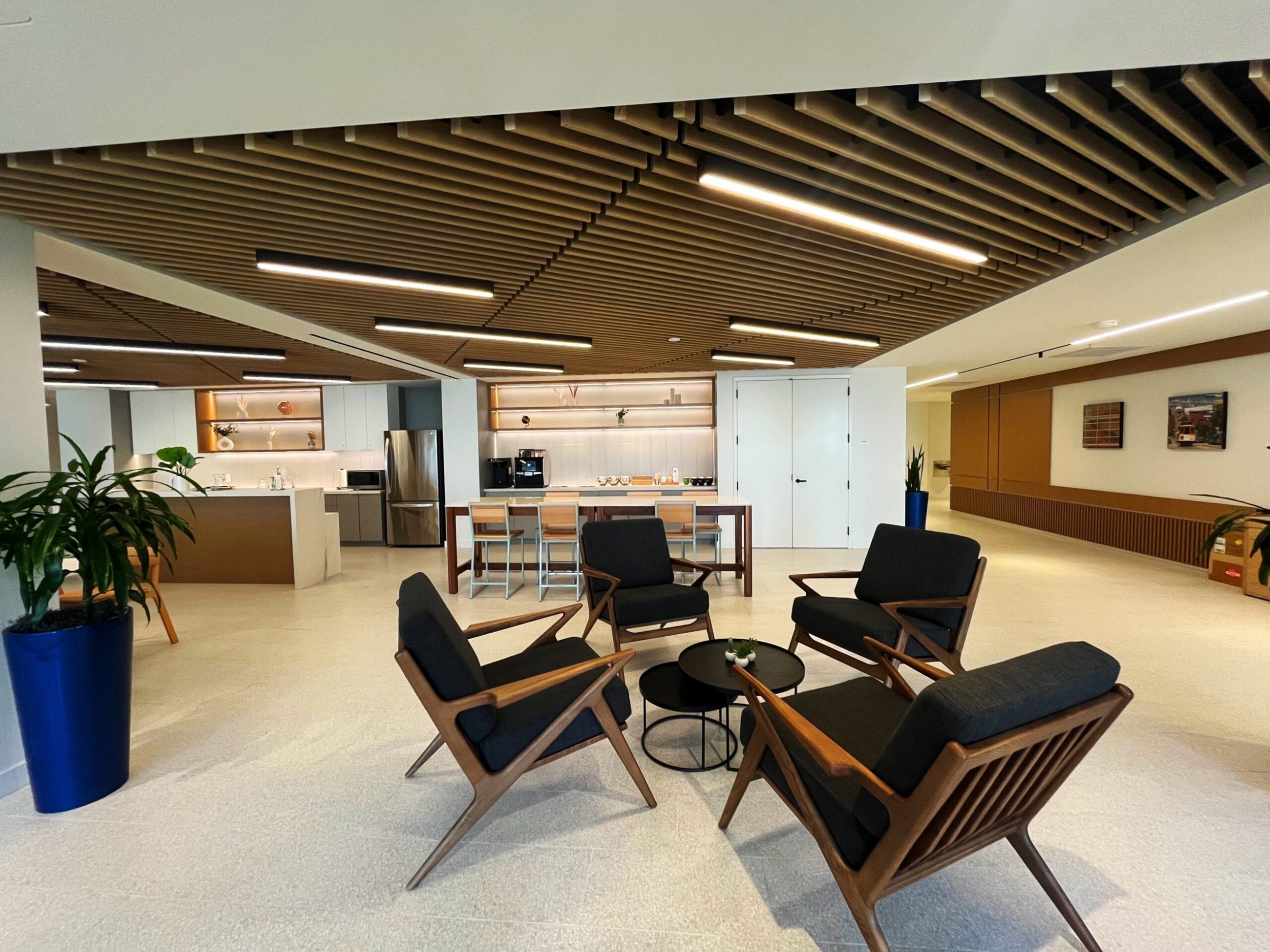Join Our Community, Rent-Free Until 2026 Learn More
Carr Workplaces
10 Ways Shared Workspaces Bridge the Gap Between Remote and In-Person Work
Oct 13th, 2025 
The way we work is shifting, and shared workspaces are playing a key role in making hybrid models not only possible, but effective. By blending the flexibility of remote work with the connection of in-person collaboration, these spaces give teams the best of both worlds. In this article, leaders from across industries share how they’re using coworking environments to spark creativity, strengthen collaboration, and keep teams aligned no matter where work happens.
Balance Community and Flexibility in Coworking
One way shared workspaces bridge this gap is by creating an opportunity for collaboration without sacrificing the flexibility you get from working at home. The problem with working from home is that it can make you feel isolated, while traditional offices are often rigid or give room for distractions. Coworking spaces strike a balance by giving professionals access to a community, spontaneous conversations, and networking opportunities, but you still decide when and how you engage.
One way to make it work is to use coworking hubs for weekly strategy sessions and client meetings while keeping deep-focus work at home. You get the best of both worlds by being in control while remaining flexible. You also get to tap into the energy of an office environment.

What makes this effective is that it forces you to be intentional about inclusion from the start. When you design a space specifically for hybrid work, rather than trying to retrofit a traditional conference room, you naturally think about everyone’s experience. The remote worker gets the same quality audio, the same ability to read facial expressions, and the same opportunity to jump into conversations naturally.
We’ve seen teams where remote members actually become more engaged because the technology amplifies their presence rather than diminishing it. Suddenly, the person calling in from Denver isn’t the forgotten voice on speakerphone – they’re an equal participant whose ideas carry the same weight.
The beauty of this solution is its simplicity: it’s not about fancy AI or complex software, but about thoughtfully designing physical spaces that make inclusion the default, not an afterthought.

Use Shared Hubs for Focused Team Convergence
Honestly, you realize the true value of shared space when you stop using it as an “office replacement” and start using it as neutral ground. You stop having your remote and in-person employees ping-pong between Zoom and Slack; instead, you find shared hubs and converge on them intentionally. Think of 3-hour work sprints and structured breakout sessions once per month. You reserve four seats, two whiteboards, and one objective. It is physical without being traditional, structured without being corporate. It gives your teams a place to re-anchor.
In a way, it’s an opportunity to reset the room without having to reset the organizational chart. It’s a validation of time and space for remote employees beyond the screen, and for in-office employees, it’s a change of pace that’s just enough disruption to invite collaboration over hierarchy. Consider this: $60 a seat per day offers much more cohesion than a three-day offsite at $10,000. The trick is to view shared workspaces as modular. You plug in, get the deep work done, then unplug with focus and energy.

Schedule Dedicated Collaboration Time in Workspaces
For hybrid workers, shared workspaces are the perfect tool to facilitate dedicated collaboration time.
The biggest drawback of pure remote work is the lack of collaboration, idea sharing, and knowledge diffusion. People inevitably become siloed, as sharing information digitally never feels genuine.
However, fully in-person work makes individual contributions more difficult, as you are constantly navigating the social domain instead of working. Not to mention the stress, expense, and inefficiency of long commutes, which many quite rightly won’t tolerate anymore.
A shared workspace once or twice a week is a perfect compromise, especially if people are encouraged to use that time for collaboration.
When we use shared workspaces, we always plan in advance what we want to discuss and prepare in advance for our contributions.
This way, we can get our main tasks done remotely without interruptions but spend our time together collaborating, discussing, and combining our ideas in a way that no Zoom chat could ever replicate.

Foster Intense On-Site Problem-Solving Sessions
Shared workspaces have the greatest impact when they are linked to projects that require immediate solutions. During one cycle of filing, 35 professionals collaborated for two full days and completed 140 complex studies that would have taken weeks if handled through remote channels. The ability to resolve issues in minutes, rather than waiting for scheduled calls, reduced correction cycles by half, and the momentum was maintained even after everyone returned to their regular setup. The difference was not in the number of hours spent but in the intensity generated by on-site problem-solving.
The physical design of the space is just as important as the schedule. The use of one long communal table instead of segmented desks led to conversations across groups of people who don’t normally interact. In one session, a comment about API formatting from an engineer transformed the way accountants prepare reports, which saved 28 hours of onboarding time per client. These small, unexpected interactions only occur when the environment is intentionally designed to facilitate them.

Design Reliable Meeting Points for Teams
At our firm, shared workspaces help make remote and in-person work feel like one team instead of two separate groups. I design these spaces as reliable meeting points where people know they can show up, collaborate, and get immediate feedback. Basically, remote employees can join video calls from dedicated booths that feel integrated with the office, while on-site people can contribute naturally without constantly asking, “Can you hear me okay?”
I like to focus on tools everyone actually uses: shared screens, project boards that sync online, and spaces that support quick brainstorming while keeping work visible to everyone. Ideas move quickly, approvals happen on the spot, and nobody gets excluded because of their location.
And, from my experience, shared workspaces succeed when being present has nothing to do with physical location and everything to do with making collaboration work smoothly for everyone involved.

Provide Neutral Ground for Hybrid Teams
A shared workspace provides hybrid teams with a place to work side by side without the burden of a traditional office structure. We have witnessed this firsthand with our team. Since some of our software engineers work remotely while the administrative and customer support teams work in-house, the teams often meet in a shared space to collaborate. When the teams convene in a shared workspace, the dynamics change. Nobody feels like a guest or outsider because it is neutral ground.
Although small, that shift helps. Instead of our remote team members dialing into a room where others already have an established rhythm, everyone starts fresh. This creates a level playing field, which makes team collaboration feel more natural and mutual. With a shared workspace, it is relatively easy to build trust that is harder to form over video calls.

Structure Weekly Routines in Shared Spaces
Many employees choose remote working for the freedom, reduced costs, and time-saving benefits it offers. However, there are certain advantages to in-person working that are hard to replicate. It’s important to balance the flexibility of remote working with the efficiency and team-building aspects of in-person working. One effective way to bridge this gap is by offering a hybrid environment that supports both styles of work.
To make the most of this approach, build structure into the weekly routine, including time in the shared workspace where:
- Team meetings are held
- New company swag is given out
- Team members are celebrated for reaching certain milestones
- Colleagues generally connect through team-building activities, including after-work events where possible
This strategy ensures that you maximize your in-office time with your team while also allowing for the flexibility of remote work.

Offer Professional Spaces for Client Meetings
Shared workspaces provide structure to remote work without sacrificing its flexibility. This is a trend we have observed within our team. More than 50% of our brokers work from home three days a week. They prefer booking a shared workspace when they need to collaborate face-to-face with colleagues or meet clients.
They appreciate it because a shared workspace creates a middle ground. In this case, remote work still feels independent, but people have an easy way to connect in person when the situation calls for it.
In our industry, trust is built through candid conversations. Having access to a professional, neutral space makes these conversations easier, especially for clients who don’t want to meet at someone’s home office or café. It means that our remote workers can still maintain credibility and personal connections without losing the efficiency of working online.

Create Bookable Rooms with Community Events
One of our methods for bridging remote and in-person events is through on-demand, bookable collaboration rooms that combine professional AV/meeting technology with timed community events and neutral, client-focused spaces. This approach provides routine, scheduled “physical touchpoints” in which remote and face-to-face participants come together for intense workshops, mentorship, and deal-closing, catalyzing referrals and participant activation.
I also complement those in-space working intervals with short, formal weekly check-in calls (10-15 minutes) to review progress, identify blockers ahead of schedule, and maintain momentum without fatigue from meetings. Short, frequent check-ins are objectively beneficial for remote work and for preventing digital fatigue.

Balance Structured Collaboration and Remote Work
Collaborative spaces will fill the gap between remote and face-to-face working as they provide a structured and time-bound collaboration window that eliminates the uncertainty of dispersed communication. When everybody understands that two afternoons a week will be allotted to on-site cooperation, the other days may be devoted to undisturbed remote work. This balance enables the prevention of inefficiency from constant check-ins without losing the energy of face-to-face communication.
The activities that are most successful in person during those shared sessions are case reviews, brainstorming, or strategy meetings. More autonomous work, including drafting, research, or analysis, will still be planned to be done on remote days. The physical work environment stops being a default and instead becomes a predictable anchor that does not limit either productivity or interaction to their appropriate value. Such a rhythm does not have the redundancy of having to repeat conversations online and in person, making the hybrid model more efficient and effective.
